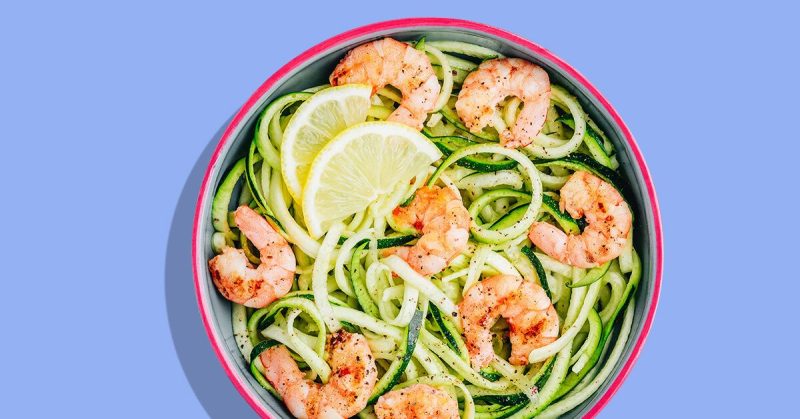F-Factor Diet: Does It Work?

The F-Factor Diet emphasizes high-fiber foods and lean proteins to support weight loss and overall health. However, there are some potential risks to keep in mind.
Want to shed a few pounds but don’t wanna follow a fad diet that leaves you hangry and miserable? Well, say hello to the F-Factor Diet — a fusion of fiber and flavor designed to transform your body and keep you feeling satisfied.
The F-Factor Diet is a nutrition plan emphasizing high-fiber foods, lean proteins, and avoiding sugary, processed foods. The theory is that by upping fiber intake, your blood sugar levels should stabilize, and you’ll feel fuller for longer.
But not to sugarcoat it (pun intended) — the F-Factor Diet comes with its own set of hurdles, as sudden increases in fiber intake can cause bloating, cramping, and gas. So should you try the F-Factor Diet? Continue reading as we evaluate the F-Factor Diet and conquer the fiber frontier!
The F-Factor Diet is a nutrition plan emphasizing the importance of incorporating high-fiber foods into daily meals. Created by registered dietitian Tanya Zuckerbrot, the F-Factor Diet has gained popularity for its focus on increasing fiber intake to promote weight loss, improve digestion, and enhance overall health.
The “F” in F-Factor stands for fiber, the hero of this diet. Fiber is a type of carbohydrate that the body can’t fully digest, so it adds bulk to your meals without adding extra calories. By incorporating high-fiber foods like fruits, vegetables, whole grains, and legumes, the F-Factor Diet aims to increase satiety (aka fullness), stabilize blood sugar levels, and support healthy digestion.
Unlike many low-calorie diet plans, the F-Factor Diet doesn’t eliminate food groups or restrict calorie intake excessively. So eating out and enjoying the odd alcoholic beverage isn’t a problem. Instead, it encourages a balanced approach to eating, combining lean proteins, healthy fats, and high-fiber carbohydrates.
The diet emphasizes the concept of net carbs, which are the digestible carbs your body breaks down and absorbs after accounting for any sugar alcohol. You calculate them by subtracting the grams of fiber from the total grams of carbs.
The F-Factor Diet also includes “unlimited” non-starchy vegetables, which provide essential vitamins, minerals, and additional fiber while keeping calorie intake in check.
While the F-Factor Diet offers several potential benefits, like weight management and improved gut health, results may vary. As with any diet, you should consult your doctor or a registered dietitian before significantly changing your eating habits.
The F-Factor Diet has three phases that gradually guide you through a gradual increase in carb intake, allowing your body to adjust and adapt while still achieving your goals.
In each phase, you aim for three meals and one snack daily, avoiding anything refined, processed, and sugary, and choosing unprocessed carbs like:
- fruits
- veggies
- whole grains
- nuts
- seeds
Phase 1 — Jump-start your weight loss
Phase 1 of the F-Factor Diet kicks things off by incorporating fewer than 35 grams of net carbs daily. These carbs are spread over approximately three servings, carefully selected to provide optimal nutrition while keeping your carbohydrate intake in check.
This phase aims to jump-start your weight loss journey, allowing you to experience early results and build momentum.
Phase 2 — Stepping up the carb game
As you progress and your body adapts, it’s time to enter phase 2. You’ll incorporate fewer than 75 grams of net carbs daily in this phase. These carbs are distributed over approximately six servings, giving you more flexibility and variety while controlling your carbohydrate intake.
Phase 2 continues to support weight loss while providing more options to satisfy your taste buds.
Phase 3 — The maintenance phase
Congrats! You’ve made it to Phase 3 — the maintenance phase of the F-Factor Diet. Here, you’ll establish a sustainable eating pattern that you can maintain indefinitely. It includes around nine servings of carbs per day, totaling fewer than 125 grams of net carbs.
The focus shifts from rapid weight loss to maintaining a healthy balance and lifestyle that works for you in the long run.
Does the F-Factor Diet live up to its fiberlicious promises? As a low-calorie, low-carb diet, it should result in weight loss.
The F-Factor Diet focuses on minimally processed, nutrient-dense foods. These whole foods nourish your body and provide a solid foundation for weight loss. By choosing foods rich in fiber, you can harness the power of this mighty nutrient to achieve and maintain a healthy weight.
But why is fiber such a game-changer when it comes to weight loss? Well, it all comes down to its unique properties. Fiber is a slow-digesting nutrient, meaning it takes longer for your body to break it down. This slow digestion process keeps you feeling full and satisfied for extended periods between meals, curbing those pesky hunger pangs that often lead to snacking and overeating.
And guess what? The evidence consistently points to the positive impact of fiber on shedding extra pounds. Increasing fiber consumption not only aids in weight loss but may also play a role in preventing obesity and related chronic diseases.
In fact, a study of 345 adults with excess weight or obesity found that fiber intake was the most significant dietary factor in promoting weight loss. This held true regardless of calorie intake or the macronutrient composition of their diet. So even if you’re not obsessing over every calorie or strictly following a specific macronutrient ratio, increasing your fiber intake can still make a substantial difference to weight loss.
The bottom line? The F-Factor Diet’s emphasis on whole, minimally processed foods and high fiber content is rooted in solid scientific evidence. Incorporating these principles into your eating habits can support your weight loss goals.
The F-Factor Diet is a flexible plan, so you can choose many options within general guidelines. Aim for lean proteins, complex carbs, and high fiber, plant-based foods.
Here are some of the key food groups and options that are encouraged on the F-Factor diet:
- High-fiber fruits. Embrace the sweetness of nature with high-fiber fruits like berries, apples, pears, and oranges. These juicy delights satisfy your taste buds and provide a burst of essential vitamins and antioxidants.
- Nutritious vegetables. Fill your plate with a rainbow of nutrient-dense vegetables. From leafy greens like spinach and kale to cruciferous veggies like broccoli and cauliflower, these fiber-packed powerhouses add color, crunch, and goodness to your meals.
- Whole grains. Incorporate whole grains like quinoa, brown rice, oats, and whole wheat bread into your diet. These wholesome options provide a hearty dose of fiber, vitamins, and minerals while keeping you satisfied and energized.
- Lean proteins. Enjoy lean protein sources like skinless poultry, fish, eggs, tofu, and Greek yogurt. These protein-packed foods help support muscle growth and repair, keeping you feeling full and satiated throughout the day.
- Healthy fats. Include nourishing fats, like avocados, nuts, seeds, and olive oil. These healthy fats provide essential nutrients and help enhance the flavor and fullness-rating of your meals.
- Fiber-friendly snacks. Choose roasted chickpeas, air-popped popcorn, and veggie sticks with hummus. These snacks offer a satisfying crunch while boosting your fiber intake.
- Moderate alcohol. Yes, you can have a drink! But only in moderation, meaning one drink daily for females and two for males.
The F-Factor Diet also offers branded powders and bars, offering convenient sources of protein and fiber.
While the F-Factor Diet doesn’t officially exclude any foods, you should minimize highly processed foods and low-quality carbs for best results. These include:
- Highly processed foods: Steer clear of sugary snacks, sodas, fast food, and processed meats. These foods tend to be low in fiber, high in added sugars, saturated fats, and artificial ingredients, which can hinder your progress.
- Refined grains: Limit your intake of refined grains like white bread, white rice, and pasta. These processed grains have been stripped of their fiber content, leaving a less nutritious and satisfying option behind.
- Sugary treats: Minimize your consumption of sugary treats like cookies, candies, cakes, and sweetened beverages. These high-sugar indulgences can lead to energy crashes, cravings, and weight gain, derailing your progress on the F-Factor Diet.
- High-fat meats: Reduce your intake of high-fat meats like fatty cuts of beef and pork and processed meats like bacon and sausage. These meats are typically higher in saturated fats and can be less supportive of your weight loss goals.
Remember, the F-Factor Diet encourages a balanced approach to eating and focuses on nourishing your body with whole, minimally processed foods. By making mindful choices and avoiding foods that are low in fiber and high in added sugars.
In the early phases, the F-Factor Diet is very similar to keto or a very low-carb diet. While F-Factor is generally considered safe for most folks, rapid weight loss, particularly in the initial phases, may increase the risk of nutrient defiiences, kidney stones, and electrolyte disturbances.
Additionally, any significant changes to your diet may cause problems if you have certain medical conditions. So it’s always best to seek professional guidance from your doctor or a registered dietician. They can provide personalized guidance, help address specific concerns, and ensure that the F-Factor Diet is a safe and suitable approach to achieving your health and weight loss goals.
Furthermore, while the F-Factor Diet may offer benefits, weighing the potential downsides before adopting this eating plan is essential. Here are some factors to consider:
- Exercise. One issue with the F-Factor Diet is its minimized emphasis on exercise. The diet even suggests that exercise may increase appetite, potentially hindering weight loss. But, being physically active has numerous benefits for weight loss and overall health. Engaging in activities like running, walking, biking, yoga, weight lifting, or playing sports can help boost your calorie burn and support your weight loss efforts.
- Nutrients. While the F-Factor Diet focuses heavily on fiber, it’s essential to maintain a well-rounded diet that includes all vital nutrients. While fiber is necessary for satiety and digestion, other nutrients like protein and fat also play significant roles in weight loss and overall health. Protein and fat can help increase fullness, support muscle maintenance, and impact calorie expenditure. So, ensure you get a balanced intake of all essential nutrients.
- Calorie intake. The F-Factor Diet may lead to consuming too few calories, especially in the initial phases. Severely restricted calorie intake over an extended period can lead to various health problems due to nutrient deficiencies. It’s crucial to monitor your calorie intake and ensure it aligns with your needs to avoid negative impacts on your health.
- Fiber-related side effects. Increasing fiber intake rapidly can result in side effects like bloating, cramping, gas, and diarrhea. While these are normal and indicate that fiber is doing its job, it’s advisable to gradually increase fiber intake if you’re not accustomed to a high-fiber diet.
- Cost considerations. The cost of the F-Factor Diet can vary, with personal startup packages reportedly priced at an eye-watering $15,000. However, you can embark on the diet independently using Tanya Zuckerbrot’s books as guidance and accessing recipes available on the F-Factor Diet website.
In the F-Factor Diet, fiber takes center stage, and lean proteins are the supporting cast. It’s a diet that gives you the freedom to eat out and doesn’t make you say goodbye to your fave foods. But while it might work for some folks, let’s not overlook the fine print.
While research specifically on the F-Factor Diet is a bit MIA, there’s no denying the benefits of a fiber-rich diet. But its laser focus on fiber might make you forget that other nutrients are crucial too.
Fiber is fantastic AF, but it’s not the superhero that can save the day alone. Instead, eating whole foods, staying active, and finding a lifestyle that suits you may be a better approach to sustainable weight loss.








